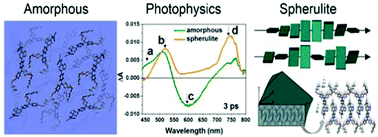Photoinduced charge recombination in dipolar D–A–A photonic liquid crystal polymorphs†
Abstract
A hexylalkoxy dipolar D–A–A molecule [7-(4-N,N-(bis(4-hexyloxyphenyl)amino)phenyl)-2,1,3-(benzothia-diazol-4-yl)methylene]propane-dinitrile, (C6-TPA-BT-CN) has been synthesized and the photophysics studied via femtosecond transient absorption spectroscopy (FsTA) in toluene and in amorphous and liquid crystalline spherulite thin films. Two spherulite macromolecular crystalline phases (banded, and non-banded) were observed through concentration dependent, solution processing techniques and are birefringent with a negative sign of elongation. A dramatic change in the electronic absorption from blue in amorphous films to green in spherulites was observed, and the molecular orientation was determined through the combined analysis of polarized light microscopy, X-ray diffraction, and scanning electron microscopy. FsTA was performed on amorphous films and show complex charge recombination dynamics, and a Stark effect, characterized from the combined TPA+˙ and [BT-CN]−˙ spectroscopic signatures at 450 nm and 510 nm and identified through spectroelectrochemistry. Radical cation dynamics of TPA+˙ was observed selectively at 750 nm with >503.3 ps (18%) recombination kinetics resulting in a rather significant yield of free charge carriers in amorphous films and consistent with previous reports on energetically disordered blend films. However, photoexcitation on large, non-banded spherulites areas (>250 μm) reveal average monoexponential charge recombination lifetimes of 169.2 ps from delocalized states similar to those observed in amorphous films and are 5× longer-lived than previous reports [Chang et al., J. Am. Chem. Soc., 2013, 135, 8790] of a related methyl-DPAT-BT-CN whose amorphous thin films were prepared through vapor deposition. Thus, the correlation between the microstructure of the blend film and the photoinduced radical pair dynamics described here is critical for developing a fundamental understanding of how dipolar states contribute to the charge carrier yield in a disordered energy system.



 Please wait while we load your content...
Please wait while we load your content...